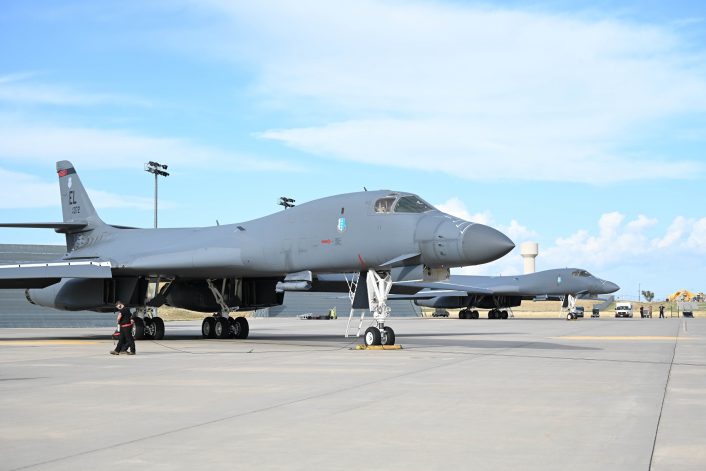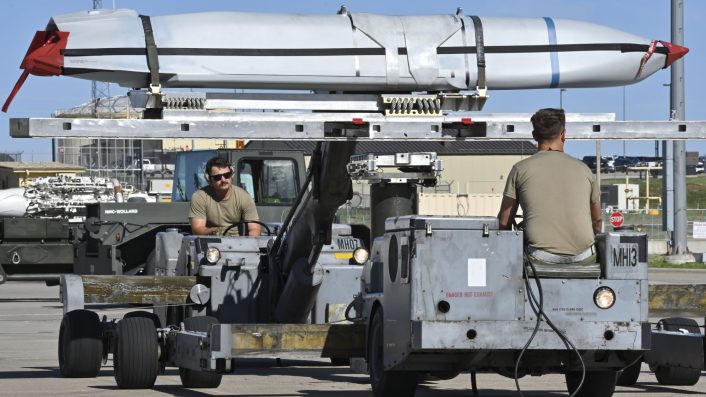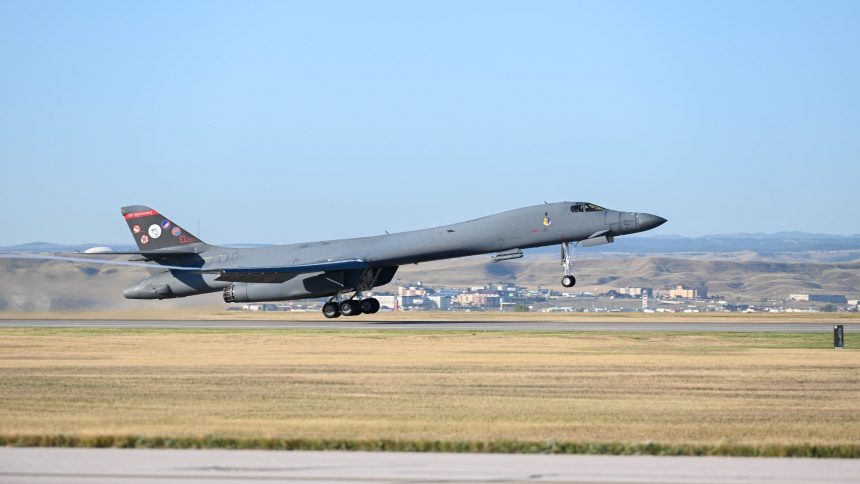Raider Reach evaluated Ellsworth’s capability to generate and execute long-range strikes around the globe with the B-1B through realistic combat and emergency scenarios simulated during the first full-scale readiness exercise in a decade.
Ellsworth Air Force Base, South Dakota, saw its first full-scale readiness exercise in over a decade last month, as the 28th Bomb Wing wrapped up the two-week, two-phase Exercise Raider Reach on Sep. 20, 2024. The entire wing, which includes five groups, 17 squadrons, supporting agencies and over 4,000 military and civilian personnel, participated.
A highlight of the exercise was the Wing’s B-1B Lancer bombers practicing flying long-range global strike missions daily in the drills’ second phase. There is no mention of weapons’ employment, although it was noted that inert weapons were loaded on the bombers.
According to the press release, Raider Reach evaluated “Ellsworth’s capabilities and resources required to generate and execute long-range strike missions around the globe through a variety of realistic combat and emergency scenarios.” The exercise comes at a time when the U.S. Air Force is training for the logistical aspects of a conventional, high-end war with China in the western Pacific, including exercises like REFORPAC (Return of Forces to the Pacific) planned in 2025.
Always Ready Raiders!
Exercise Raider Reach recently wrapped up at @28thBombWing, where +4,000 military & civilian personnel sharpened their skills during this 2-week, 2-phase combat readiness exercise.
Read more here: https://t.co/vAQuQB0nNZ
📸: A1C Kenney & Amn Carlberg pic.twitter.com/xbm00vjptD
— Air Force Global Strike Command (@AFGlobalStrike) September 25, 2024
Combatant commands and fighter, bomber, mobility and refueling wings have been individually conducting their own mobilizing and force generation exercises, similarly to the 28th BW with Raider Reach. REFORPAC, however, practices mobilizing for war in the western Pacific as an entire air force, with all units and bases in the continental U.S., Alaska, Hawaii and Guam converging in the Pacific in the 14-day exercise.
The 28th BW at Ellsworth AFB is one of the two bases responsible for the operation and maintenance of the B-1B bomber. Part of the AFGSC (Air Force Global Strike Command), it operates 27 B-1 bombers. Interestingly, as The Aviationist had reported, starting Feb. 2025, B-1s from Ellsworth would move to Grand Forks AFB, North Dakota, in a temporary 10-month move.
This is because Ellsworth AFB is renovating its runway to prepare for the arrival of the B-21 Raider, as it has been selected as the first base for the B-21. Whiteman AFB, Missouri, and Dyess AFB, Texas, have been selected as the second and third locations to host the new strategic stealth bomber.

High-pressure exercise
Raider Reach comprised everything from ammunition loading exercises (seen in the photos of the inert variant of the AGM-158 JASSM being loaded) and B-1B Lancer flying sorties everyday, amid “degraded” scenarios involving base security breaches and enemy drone activity being dealt with simultaneously. Assessors noted the base’s and the personnels’ performance in realistic combat scenarios, together with remarks and identified areas for improvement. The overall exercise was overseen and evaluated by 33 exercise planners and 109 Wing Inspection Team members, said the unit in the press release.
“The [initial] goal was to stress unit capabilities and identify strengths and weaknesses in order to maximize combat effectiveness,” said Master Sgt. Eric Tindall, 28th BW Inspector General inspector. “The end goal is to provide our combatant commanders and Air Force leadership at all levels with the wing’s overall combat readiness.”
The first phase of the exercise saw personnel being processed through a “deployment function line” while cargo was prepared by the 28th Logistics Readiness Squadron to be sent down range. This tested the wing’s ability to deploy on short notice while “being in a degraded and contested environment.” WIT members documented and graded the wing on duty specific criteria, providing critical areas of improvement to leadership teams and players involved.
“We can only improve from here,” said Chet Weymouth, 28th LRS installation deployment officer. “I’m glad there were issues. That forces us to re-evaluate our processes to make sure we are mission ready for real-world deployments.”
With the objective of challenging the wing, various scenarios were prepared, including a simulated drone crash, suspicious vehicle activity near the base, and several instances of declaring Force Protection Conditions Charlie and Delta, to test the base’s response.

Ammunition loading, B-1B strike flights
The phase two of the exercise tested Ellsworth’s ability to fight from home, initiating daily B-1B Lancer flying missions from both the 34th and 37th Bomb Squadrons, 24-hour maintenance operations, and the uploading of inert munitions for the simulated combat scenarios.
“Exercises like this make real-world situations feel less abnormal,” said Senior Airman TreQuawn Tomlin, 34th Bomber Generation Squadron crew chief. “We’re so used to doing the work that if something real-world comes up, we already know what to do; we feel prepared for it.”
A US Air Force 37th Bomber Generation Squadron aerospace propulsion craftsman poses beside a B-1B Lancer jet engine during exercise Raider Reach 2024 at Ellsworth Air Force Base in South Dakota on Sept. 17.https://t.co/ASuTN3rxvp pic.twitter.com/a2xKOInAbZ
— Ryan Chan 陳家翹 (@ryankakiuchan) September 24, 2024
Wings are required to conduct Combat Readiness Exercises annually with the intent to ensure the highest levels of readiness across the force, said the service. Executing Raider Reach allowed Ellsworth to meet this requirement for the year while also providing data that will result in mission enhancements for many Air force Specialty Codes, noted the press release.
“In line with the SECAF initiative for Great Power Competition, exercises are key to Airmen development,” said Tindall. “Exercises of this magnitude provide Airmen with the tools and experience to be able to execute a real-world mission while using the lessons learned to win today and dominate tomorrow!”
The officially released pictures also showed the 28th Maintenance Group and weapons load crews loading DATM-158 (Dummy Air Training Missile 158) in the B-1B’s weapons bay. The DATM-158 simulates the shape and weight of the AGM-158A/B JASSM (Joint Air-to-Surface Standoff Missile) and an AGM-158C LRASM (Long-Range Anti-Ship Missile).
A USAF B-1B Lancer bomber with a Joint Air-to-Surface Standoff Missile (JASSM) flies in the skies above Edwards Air Force Base, California, Nov. 20. The flight was a demonstration of the B-1B’s external weapons carriage capabilities. pic.twitter.com/i29FL6HO7K
— Ryan Chan 陳家翹 (@ryankakiuchan) November 24, 2020
The JASSM’s surface and ship-strike variants would be the mainstay of the U.S. Air Force’s air-launched standoff strikes, and are particularly critical in a maritime theater against the PLA Navy’s warships. These weapons would also be key in hitting North Korean land targets, deep behind its lines.
The U.S. Air Force says the B-1B can carry 24 JASSMs, in a configuration that includes only weapons carried by the Rotary Launcher Systems located inside the three weapons bays. The Air Force is also working on new external hardpoints to increase the payload, with 12 additional JASSMs expected.
28th MG’s crews installed the RLS in the B-1B’s Intermediate Weapons Bay to operate in an “operational tempo that simulated deploying from Ellsworth, requiring them to quickly prepare jets for takeoff,” mentioned the unit. Meanwhile, personnel from the 28th Operations Support Squadron “ensured safe and secure B-1 aircrew communication to carry out simulated long-range strikes.”









